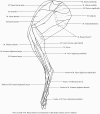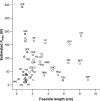Functional specialisation of the pelvic limb of the hare (Lepus europeus)
- PMID: 17362487
- PMCID: PMC2100287
- DOI: 10.1111/j.1469-7580.2007.00704.x
Functional specialisation of the pelvic limb of the hare (Lepus europeus)
Abstract
We provide quantitative anatomical data on the muscle-tendon architecture of the hare pelvic limb (specifically muscle mass, fascicle length, pennation angle, tendon mass and length). In addition, moment arms of major pelvic limb muscles were measured. Maximum isometric force and power of muscles, the moment of force about a joint, and tendon stress and strain were estimated. Data are compared with published data for other cursorial mammals such as the horse and dog, and a non-specialised Lagamorph, the rabbit. The pelvic limb of the hare was found to contain substantial amounts of hip extensor and adductor/abductor muscle volume, which is likely to be required for power production and stability during rapid turning. A proximal to distal reduction in muscle volume and fascicle length was also observed, as is the case in other cursorial quadrupeds, along with a reduction in distal limb mass via the replacement of muscle volume by long distal limb tendons, capable of storing large amounts of elastic energy. The majority of hare pelvic limb muscle moment arms varied with joint position, giving the hare the capacity to vary muscle function with limb posture and presumably different locomotor activities.
Figures







Similar articles
-
Functional specialisation of the thoracic limb of the hare (Lepus europeus).J Anat. 2007 Apr;210(4):491-505. doi: 10.1111/j.1469-7580.2007.00703.x. J Anat. 2007. PMID: 17428206 Free PMC article.
-
Functional anatomy and muscle moment arms of the pelvic limb of an elite sprinting athlete: the racing greyhound (Canis familiaris).J Anat. 2008 Oct;213(4):361-72. doi: 10.1111/j.1469-7580.2008.00961.x. Epub 2008 Jul 22. J Anat. 2008. PMID: 18657259 Free PMC article.
-
Functional anatomy and muscle moment arms of the thoracic limb of an elite sprinting athlete: the racing greyhound (Canis familiaris).J Anat. 2008 Oct;213(4):373-82. doi: 10.1111/j.1469-7580.2008.00962.x. J Anat. 2008. PMID: 19034998 Free PMC article.
-
Contributions to the understanding of gait control.Dan Med J. 2014 Apr;61(4):B4823. Dan Med J. 2014. PMID: 24814597 Review.
-
How musculotendon architecture and joint geometry affect the capacity of muscles to move and exert force on objects: a review with application to arm and forearm tendon transfer design.J Hand Surg Am. 1992 Sep;17(5):799-804. doi: 10.1016/0363-5023(92)90445-u. J Hand Surg Am. 1992. PMID: 1401783 Review.
Cited by
-
Comparative triceps surae morphology in primates: a review.Anat Res Int. 2011;2011:191509. doi: 10.1155/2011/191509. Epub 2011 Jul 28. Anat Res Int. 2011. PMID: 22567288 Free PMC article.
-
Ontogenetic allometry and architectural properties of the paravertebral and hindlimb musculature in Eastern cottontail rabbits (Sylvilagus floridanus): functional implications for developmental changes in locomotor performance.J Anat. 2019 Jul;235(1):106-123. doi: 10.1111/joa.12991. Epub 2019 May 17. J Anat. 2019. PMID: 31099418 Free PMC article.
-
Arboreality, terrestriality and bipedalism.Philos Trans R Soc Lond B Biol Sci. 2010 Oct 27;365(1556):3301-14. doi: 10.1098/rstb.2010.0035. Philos Trans R Soc Lond B Biol Sci. 2010. PMID: 20855304 Free PMC article. Review.
-
From fibre to function: are we accurately representing muscle architecture and performance?Biol Rev Camb Philos Soc. 2022 Aug;97(4):1640-1676. doi: 10.1111/brv.12856. Epub 2022 Apr 7. Biol Rev Camb Philos Soc. 2022. PMID: 35388613 Free PMC article. Review.
-
Does intrauterine crowding affect the force generating capacity and muscle composition of the piglet front limb?PLoS One. 2019 Oct 10;14(10):e0223851. doi: 10.1371/journal.pone.0223851. eCollection 2019. PLoS One. 2019. PMID: 31600318 Free PMC article.
References
-
- Aerts P. Vertical jumping in Galago senegalensis: the quest for an obligate mechanical power amplifier. Philos Trans R Soc Lond B Biol Sci. 1998;353:1607–1620.
-
- Alexander RM, Vernon A. Mechanics of hopping by kangaroos (Macropodidae) J Zool. 1975;177:265–303.
-
- Alexander RM, Bennet-Clark HC. Storage of elastic strain energy in muscle and other tissues. Nature. 1977;265:114–117. - PubMed
-
- Alexander RM, Jayes AS, Maloiy GM, Wathuta E. Allometry of the leg muscles of mammals. J Zool Lond Series A. 1981;194:227–267.
-
- Alexander RM, Dimery NJ, Ker RF. Elastic structures in the back and their role in galloping in some mammals. J Zool Lond (A) 1985;207:467–482.
Publication types
MeSH terms
Grants and funding
LinkOut - more resources
Full Text Sources
Miscellaneous

